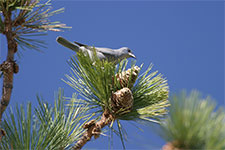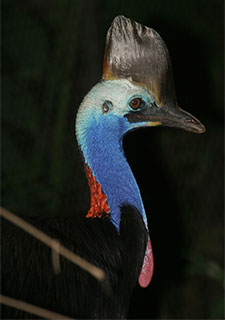Threatened Birds May Be Rarer than Geographic Range Maps Suggest
December 10, 2007
By Kim McDonald

The Pinyon Jay is an important seed disperser of North American pinyon pines, but globally threatened with extinction. According to the study, 52 percent of its range is overestimated.
Photo Credit: Cagan Sekercioglu
Geographic range maps that allow conservationists to estimate the distribution of birds may vastly overestimate the actual population size of threatened species and those with specific habitats, according to a study published online this week in the journal Conservation Biology.
"Our study found that species ranges in general tend to get overestimated, but that this trend is particularly pronounced for birds that are threatened, rely on specialized diets or have small habitats," said Walter Jetz, an assistant professor of biological sciences at UC San Diego and the lead author of the study, which will appear in the February issue of the printed journal. "This suggests that many threatened species of birds may be even rarer than we believe and are in greater danger of going extinct."
"Our findings indicate that the ranges of most vulnerable bird species are experiencing the highest overestimation, thereby painting a rosier picture of their distributions than is actually the case," said Cagan Sekercioglu, a senior research scientist at Stanford University and a co-author of the study. "This suggests that the conservation status of many narrow-ranging, specialized and threatened bird species may be worse than we think."
Jetz, Sekercioglu and James E.M. Watson of Britain's Oxford University evaluated geographic range overestimation and its potential ecological causes for 1,158 bird species across 4,040 well-studied survey locations in Australia, North America and Southern Africa. Comparing the range maps with actual bird surveys, such as those conducted by the Audubon Society, the scientists found that most species actually occur in only 40 to 70 percent of the range suggested by their range maps. In other words, these birds are not actually found in 30 to 60 percent of their supposed range.
The scientists also found range overestimation increases for species with smaller ranges and with more specialized dietary and habitat requirements. Range maps most strongly overestimate the distribution of narrow-ranging species and ecological specialists. As a consequence, species threatened or near threatened with extinction are also subject to particularly high range overestimation, on average 62 percent overestimation compared to 37 percent overestimation in non-threatened species.

The Southern Cassowary may be the most important seed disperser in Australian and New Guinea rainforests, but is absent from 59 percent of its range in Australia.
Photo Credit: Cagan Sekercioglu
The researchers' study was limited to mostly temperate areas with relatively high-quality data on bird distributions. They said they expect that in the tropics, where the majority of bird species reside, but where research and data on bird distributions are more limited, that the problem of ounderstimating bird species' ranges may be even more extensive than the scientists found for Australia, North America and South Africa.
"People have been treating tropical and temperate data on bird distributions as if they are of equal quality," said Walter Jetz. "But the overestimation is especially large for tropical species, which have much smaller geographic ranges, smaller population sizes, are more specialized, and are in greater danger of extinction than those in temperate areas."
Jetz and Allen Hurlbert of the National Center for Ecological Analysis and Synthesis in Santa Barbara published a related study in the August 14 issue of the Proceedings of the National Academy of Sciences, that found that range maps of birds less than 200 kilometers in area also "overestimate the area of occupancy of individual species and mischaracterize spatial patterns of species richness."
Jetz added that range maps are becoming especially important for ecologists making projections of the impact of climate change on the health of specific populations and that these two studies demonstrate that conservationists need to be especially careful when making predictions about future risks to species during rapid climate change.
"If we're starting with a range estimate for a population that is much larger than it truly is, then we have started with the wrong parameter for our future projections of climate change," he said. "If you've already started with an overestimate of the range, then there's a real danger in underestimating the risks of extinction in future projections of climate change."
